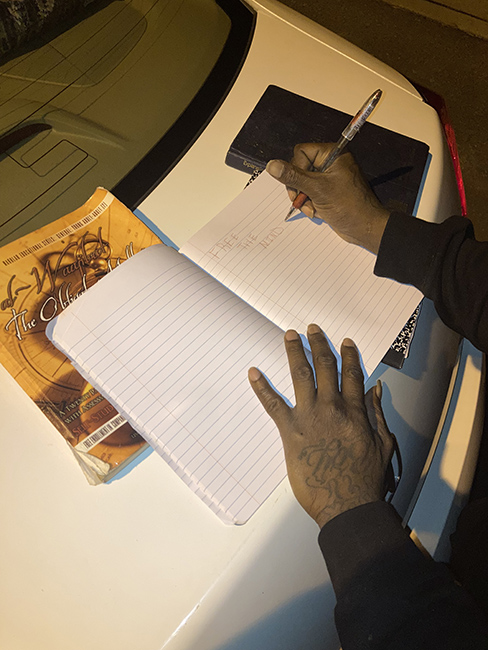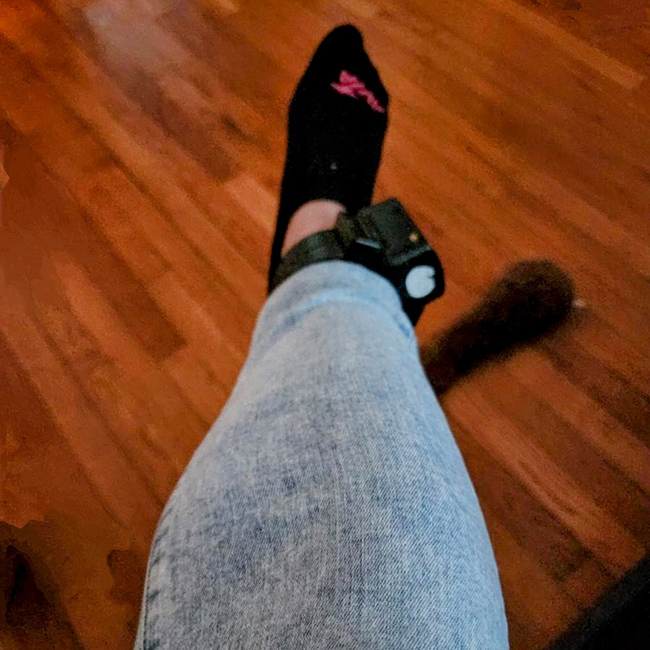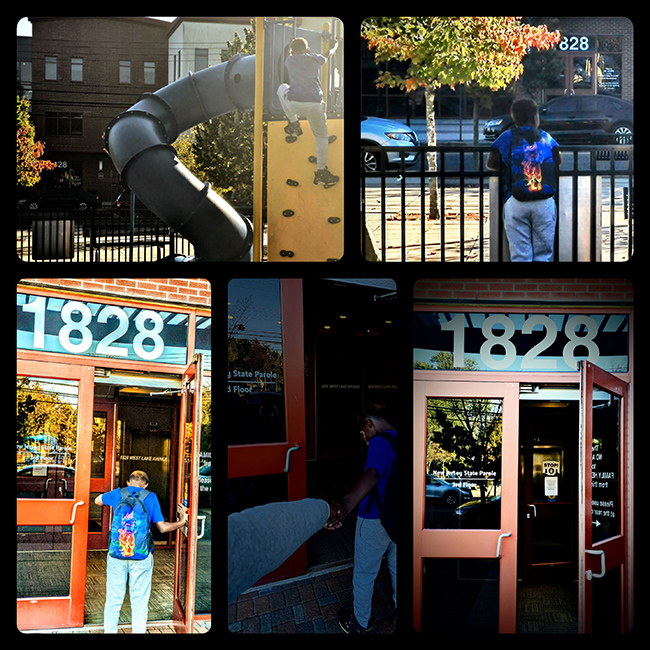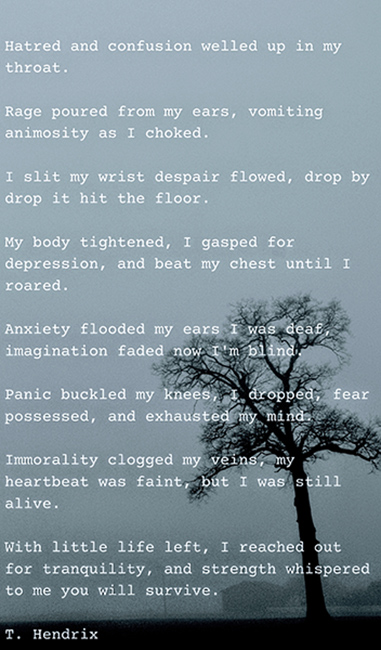“Once You’re Arrested, You Lose So Much”
A Photovoice Study on the Pretrial Experience in New Jersey
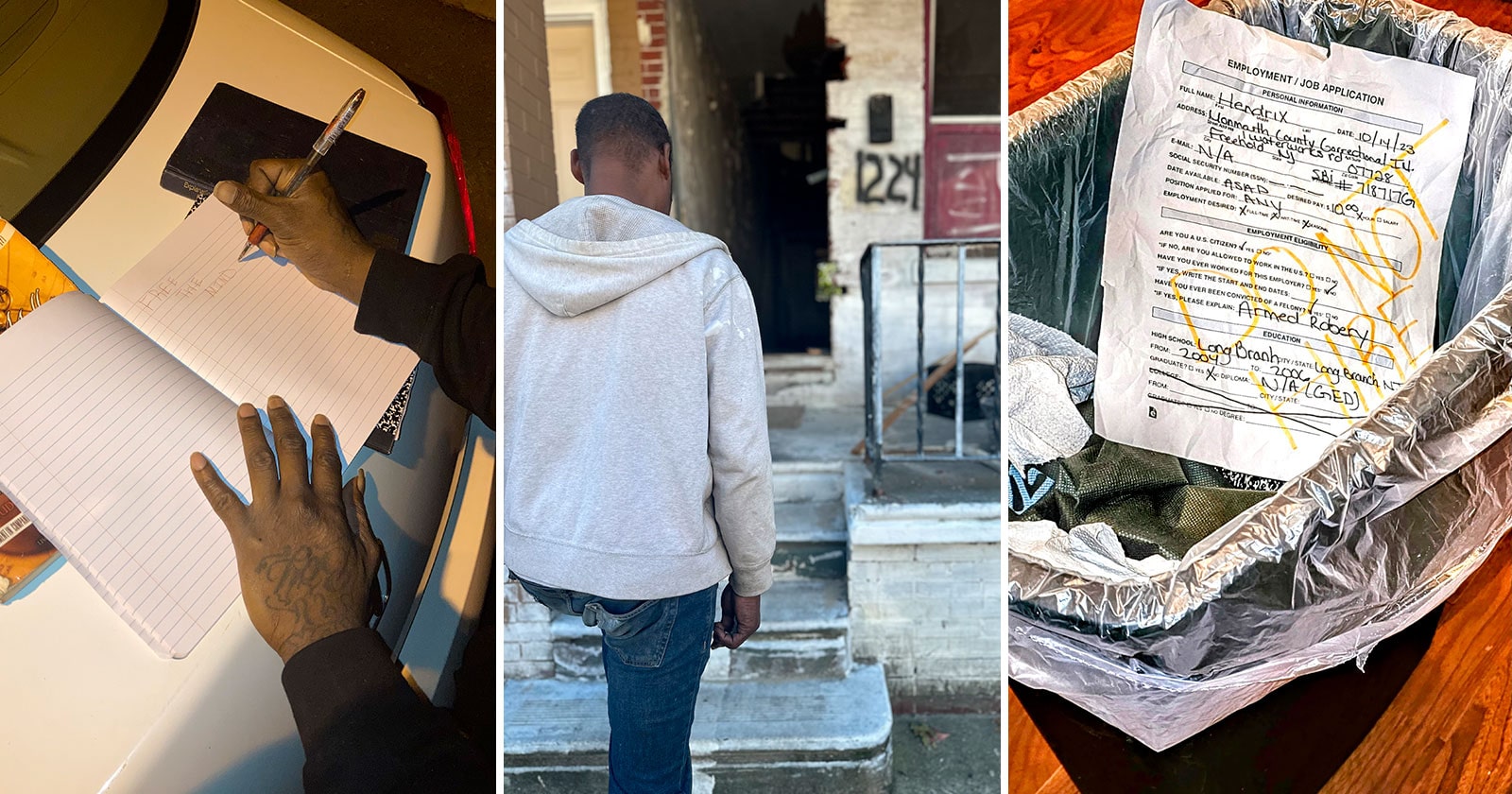
This report presents findings and photographs from the New Jersey Criminal Justice Reform Advancing Racial Equity (NJ CARE) photovoice study. In this research study, three people who had experience with the New Jersey pretrial system as defendants used photovoice, a participatory research method, to explore the connection between pretrial experience and wellbeing. The people who took part in this study (referred to as photographers) took photos that capture their experiences with the pretrial period and discussed the photos to shed light on their meaning.
The pretrial period is the time between a person’s initial encounter with law enforcement and the point at which a decision is made about their case. Through photos, group discussion, and an online photo gallery, the three photographers explore issues within the pretrial system and make recommendations for how it can be improved.
New Jersey’s Pretrial Process and the NJ CARE Study
When a person is arrested, their case moves through several processes that make up the pretrial period: the time between a person’s encounter with law enforcement and the point at which a decision is made about their case. During this period, the person has been accused of committing a crime but has not been found guilty. They may plead guilty, take their case to trial where their guilt or innocence will be determined, or have their case dismissed. A great deal of evidence has documented the presence of racial disparities throughout the pretrial process, including related to arrest, money bail, pretrial detention, case disposition, and sentencing. These disparities have important implications for equity related to wellbeing, a public health concept that refers to the presence of positive emotions (such as happiness) and the absence of negative ones (such as fear). Socioeconomic factors, relationships and community ties, physical health, mental health, emotional health, and other factors can all contribute to wellbeing. Contact with the criminal legal system is associated with a variety of adverse effects on wellbeing. Even early forms of contact, such as police stops and arrests, are associated with diminished mental health. Incarceration can have negative consequences: it can cause people to lose employment; it can disrupt their family lives or housing stability; and it can negatively impact health and mental health.
On January 1, 2017, the State of New Jersey implemented Criminal Justice Reform (CJR), a sweeping set of changes to its pretrial justice system. With these reforms, the state shifted from a system that relied on money bail to a system that uses a risk assessment tool—the Public Safety Assessment (PSA)—to determine whether someone who has been accused of a crime is detained in jail or released to their community, and if released, with what conditions. The PSA is meant to inform decision-making based on how likely the person is to fail to appear at future court hearings and commit a crime if released. The reforms virtually eliminated the use of money bail—which disproportionately harms people of color and low-income individuals—as an initial release condition. The reforms also created an option for pretrial detention without bail for people determined by the PSA to have a high risk of failing to appear in court or committing a crime before trial; established a pretrial monitoring program; and instituted speedy-trial laws that impose time limits for the processing of certain cases. New Jersey’s goals for these reforms were to improve fairness throughout its pretrial system and reduce unnecessary pretrial detention while protecting public safety and maintaining court appearance rates.
Pretrial processes in New Jersey (like most states) are technical and complex. There are several steps in the process that each involve different actors, including police officers, pretrial services staff, prosecutors, defense attorneys, and judges. Each of these actors has a different role in pretrial processes and the decisions that are made about a person’s arrest, booking into jail, and possible release during the pretrial period. These processes can be difficult to understand, especially for someone going through the stressful experience of being arrested and facing a charge.
Since the implementation of CJR, when individuals are arrested in New Jersey, they can be issued either a warrant (where they are booked into jail with judicial approval) or a summons complaint (where they are released into the community and given a date to appear in court). If police officers want to pursue a warrant or is not sure whether to seek a warrant or issue a summons complaint, they run the PSA to generate risk scores for the person who was arrested. The PSA is an actuarial tool designed to estimate each individual’s relative risk of not appearing in court and/or incurring a new arrest during the pretrial period. The officer then determines whether to issue a summons or pursue a warrant based on the charge, the PSA risk scores, and guidelines issued by the state attorney general.
Individuals who have been issued a warrant are booked into jail pending a first appearance hearing (bail is no longer an option post-reforms), which must occur within 48 hours. At this point, the preliminary PSA report that was produced at arrest is reviewed by Pretrial Services staff to ensure it was calculated accurately. A final PSA report is generated at this stage, and New Jersey’s customized Decision Making Framework (DMF) produces recommendations for release conditions based on the final PSA risk scores and state-specific policies and guidelines. The DMF generates three possible release recommendations: (1) release on own recognizance/without conditions (ROR); (2) release to one of four levels of pretrial monitoring by Pretrial Services; or (3) no release. The PSA report and DMF recommendations are then shared with the presiding judge, prosecutor, and public defender/defense attorney ahead of the first appearance hearing.
At the first appearance hearing, the prosecutor, the defense attorney (who is often a public defender), and the judge are involved in making decisions about release for individuals who had been booked into jail. If the prosecutor files a motion for pretrial detention at the first appearance hearing, the person who was charged is typically held in jail pending a detention hearing, at which point the judge will determine whether to detain the individual throughout the entire pretrial period or to release them on ROR or pretrial monitoring. Detention hearings must occur within three business days of first appearance hearings, but since there are often brief adjournments granted to either the prosecution or the defense, in practice detention hearings commonly occur about a week after first appearance hearings.
As was the situation before the reforms, the judge may also dismiss a case, or the person who was charged may accept a plea deal at any point in the pretrial process. Most cases are disposed of after these initial hearings. Disposition may happen through a variety of ways, including trial, plea, or dismissal.
New Jersey also has speedy-trial laws that set clear time limits on the amount of time prosecutors have to reach case-processing milestones, such as indictment and case disposition, and on the amount of time courts have to schedule a first appearance hearing following an initial jail booking. If the prosecution fails to meet these deadlines in a case, then the court must release the person who was charged while the case is awaiting disposition. There is an overall time limit of two years to dispose of a case. However, the time clock on a case can be “paused” for several reasons if requested by prosecution or defense, which would extend the time it takes to meet a case’s next milestone(s).
The New Jersey Criminal Justice Reform Advancing Racial Equity (NJ CARE) study assesses the impact of CJR on racial equity. The study also explores people’s experiences with the pretrial system, their perceptions of equity, and how their wellbeing was affected during the pretrial period. A part of the NJ CARE study, this photovoice component uses a participatory research method in which participants take photographs that show their experiences and perspectives and discuss the photos to shed light on their meaning.
Results from the NJ CARE study will appear in a report to be published in Fall 2024.
Findings
In their photography and analysis, the photographers—Baiyinah, Talyesse, and Pooda—elevated five themes related to how their sense of wellbeing changed during their interactions with pretrial system:
- the pretrial period felt stressful, confusing, and overwhelming;
- mental and physical health declined during the pretrial period;
- the pretrial period strained family relationships;
- pretrial involvement worsens financial health for both communities and the individuals navigating the system; and
- there is a powerful stigma associated with being charged with a crime.[1]
The photographers also suggested ways to address some of the issues raised.
The results of this photovoice study are not meant to be representative of the larger New Jersey population’s experiences with the pretrial system. Instead, the study provides an opportunity to give voice to the perspectives and recommendations of a small number of people.
1 “Nothing was explained to me” The pretrial period felt stressful, confusing, and overwhelming
The pretrial period felt immensely stressful to the people experiencing it. The three photographers pointed to three factors that heightened their stress during this period: 1) lack of information from official sources about their case; 2) uncertainty and not knowing what would happen to them and their case; and 3) worsening mental health during the pretrial period.
Confusion and lack of information about their cases added stress at an already difficult time
The entire pretrial services as a whole needs to be furthermore explained.
Talyesse
New Jersey’s pretrial process has several steps that can be confusing for someone learning about the processes while also experiencing them. Photographers said that the court did not adequately describe pretrial processes—like the risk assessment score and release conditions—or timelines. Instead, they said, the system treated them as if they must have been charged before and already knew what was going to happen.
For example, Talyesse described her confusion around the risk assessment score and pretrial conditions. “I didn’t understand it,” Talyesse said. “I’ve never been arrested before…This was all new for me…Nothing was explained to me.” Talyesse’s photo of a letter from her young son shows their confusion about the risk assessment score and how the court decided the pretrial conditions. Despite it being her first offense, Talyesse was detained in jail and initially denied pretrial release because of the severity of her charge. Both she and her public defender were surprised when she was denied release not once, but twice. Talyesse struggled to explain to her young son why she could not come home, because she didn’t understand herself why she was being denied release.
I have a son, and [I was] not being able to explain to him like anything. It got to a point where I asked them [my family] to stop putting my son on the phone. It was like breaking my heart more because I didn’t have any answer for him, not one answer. I didn’t have an answer for myself, so it was just really hard like it just made every day so long.
Talyesse
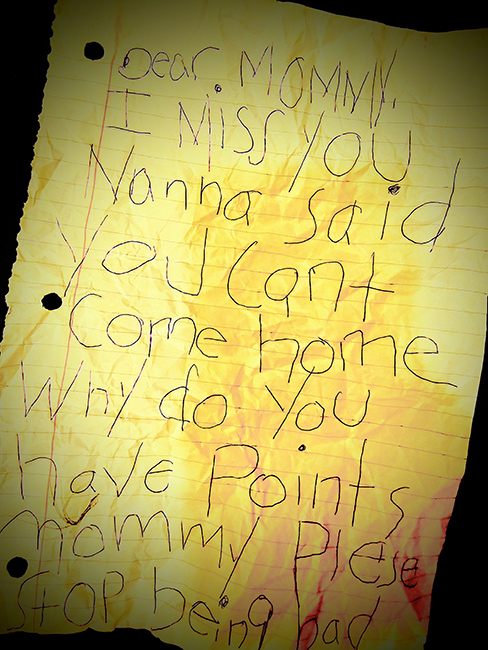
How can you explain a point system to your child that has never been explained to you?
Talyesse
The photographers didn’t feel the court was providing them with enough information about their cases and how they were progressing. For example, while Talyesse was waiting to learn if she would be released pretrial, her primary communication with her public defender was through form letters that arrived at the jail. This process was slow and didn’t provide a way to get her questions answered. If she wanted to reach her public defender by phone, she needed to put in a request with a social worker. Waiting on letters and with limited access to her public defender, Talyesse felt scared. “I just kept thinking, ‘What is going to happen to me?’ I have to put my trust in this one person who has my folder, and they are supposed to be protecting my case, which is my life. You have no choice but to trust them. And to not be able to reach them and that’s your only form of trust—the only person who has any knowledge about your case. To not have that… What do you have?”
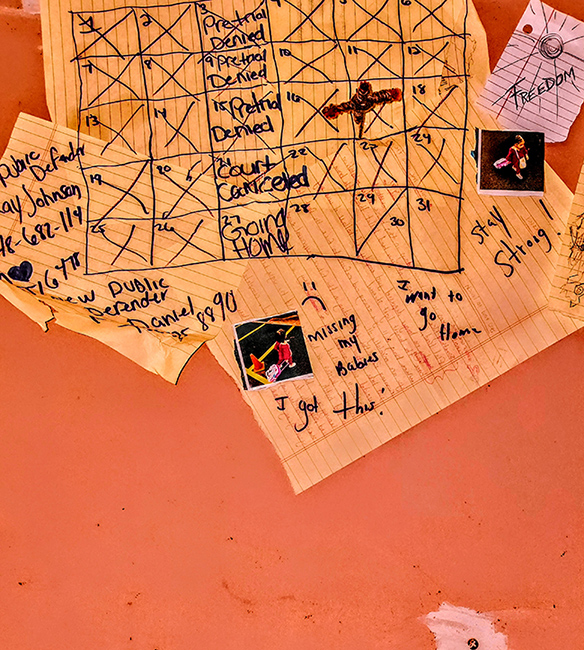
Every night for 26 days, I stared up at my bunk and prayed. After three denials and court being postponed, my prayers are finally answered. My third public defender remembered my name, studied my case, and I went home to my family.
Talyesse
Uncertainty about what would happen to them was a steady source of anxiety
The first time we were going to court to see if I could fight my trial at home [my public defender] literally says verbatim, "Oh, I know you'll be good because you have no points." I didn't know what he was talking about whatsoever. Had no idea what he was talking about, nor did he explain it. He just told me he had it. They denied me, and said I wasn't going home. Now the uncertainty [was] worse.
Talyesse
With limited access to her public defender and mounting uncertainty about what would happen with her case, Talyesse turned to people she knew who had been arrested. Their experiences became worst-case scenarios that she worried she was destined to experience. She said, “I'm thinking in my head like, ‘All right, oh man, I am going for 15 [years]. Oh no, now I'm going for this. Oh, now this is happening,’ because I wasn't given any [official] information whatsoever.” She said that not knowing what sentence she was facing and how long she might be away from her family was harder on her mentally than if she knew what to expect. Baiyinah also worried that if her case went to court and she was found guilty, she would be given the maximum sentence.
Both spoke about how the uncertainty of what might happen to them had intense mental health repercussions. “The uncertainty—the not knowing—shut me down,” Baiyinah said. “That was a big part of that bad depression that I was in.” She also felt that she had lost control over what was happening with her case, which triggered anxiety. “It triggered my anxiety—not being able to control and not knowing,” she said. “My case switched judges, switched prosecutors. One was adamant on [one aspect of the case]. And then the other one was going in a whole total different direction. It was really stressful.”
The photographers felt anxious and/or depressed during the pretrial period
I lost my job [from the charges], so I was home and I slept all day every day. And it was getting bad, and to the point where, like, I wasn't even getting up for days. I was, like just shut them all out.
Baiyinah
Feeling overwhelmed by the stress, the photographers illustrated how this stress manifested in anxiety, depression, and a sense of dread. “In the midst of trauma and you dealing with trauma at its height, mentally there's not much clarity there,” Baiyinah said. “You be kind of all over the place, you know, and your life don't kind of, well, for me it don't kind of resemble that of normalcy. It'd be resembling that of chaos.” Baiyinah made an image to capture the chaos she felt throughout the pretrial period. In it, pills are being sorted into a daily organizer, but they don’t seem to fit. Instead, they spill out across a glass table that Baiyinah rubbed with oil to indicate the chaos she felt during this period.

Dealing with the anxiety left from the trauma. This picture was trying to speak from the impact and the trauma of it [from arrest until the sentence is completed], and how it causes mental health issues. The medication is a representation of that.
Baiyinah
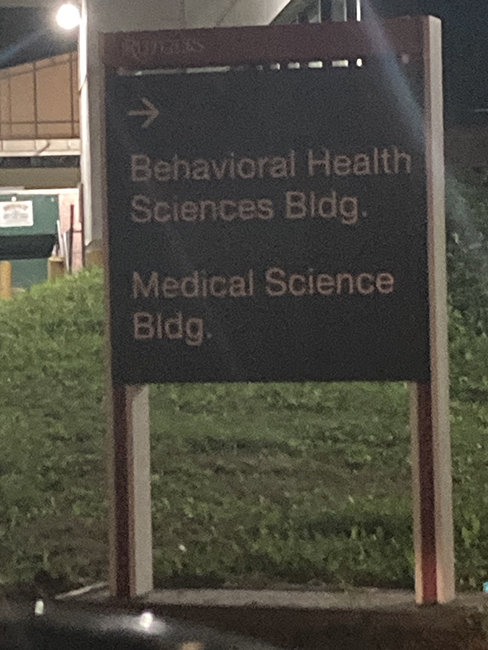
Undoing trauma one day at a time, one person at a time.
Baiyinah
The photographers spoke about how their anxiety and depression manifested in changes to their sleep, significant weight loss/gain, and use of alcohol to avoid their feelings. “My anxiety has been heightened [since getting arrested],” Baiyinah said. “I thought I was in a better place mentally, emotionally dealing with traumas from my past. This whole situation allowed it to resurface: I can’t sleep at night, bad dreams.”
Talyesse’s photo below shows two different mental states that a person could be in during the pretrial process. On the left, a woman reads a book and drinks a mug of tea. On the right, she looks disheveled and unconscious, lying on the ground, surrounded by empty beer cans and syringes. This photo, Talyesse said, “is showing how your mentality can…how you can, fall into a depression or just like try to numb anything that you possibly can just to suppress everything. It shows the mental state just completely changing.”
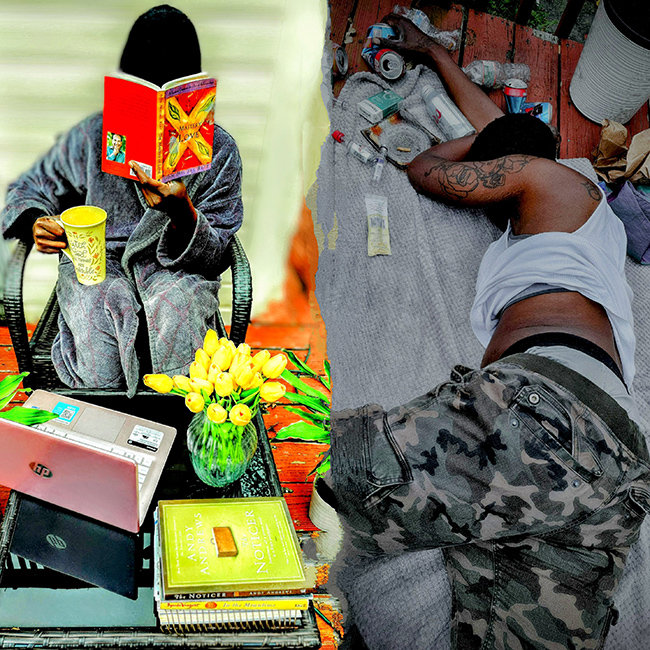
I fell into a deep depression while awaiting an answer after my arrest. I would have done anything to feel completely numb.
Talyesse
For Baiyinah, the pretrial period was so overwhelming that she “wasn’t even getting up for days.” Eventually, she received medication and treatment that helped her manage her anxiety. Her experience getting help is pictured in the behavioral health center sign.
For Talyesse, help came in the form of a counselor whom she connected with after the pretrial process.
2 “You can’t have one without the other” Mental and physical health declined during the pretrial period
Researchers have found that initial criminal legal contact, such as police stops and arrests, as well as more intense involvement, like detention or incarceration, can be associated with adverse health outcomes. For example, arrests often lead to stigma; trauma stemming from physical police contact; disruptions to work, social, and family life as one navigates bureaucratic requirements; and uncertainty about the future.
The three photographers emphasized how pretrial monitoring affected both their mental and physical health. They drew a strong connection between their mental and physical health in this period, saying that “you can’t have one without the other.” The extreme stress they felt during this time caused difficulty sleeping, increased blood pressure, and significant changes in weight. Highlighting this connection, one photograph overlays blood pressure numbers and confusing pretrial processes over a person who is having their blood pressure read. Question marks link a sense of confusion and stress to the person’s increased blood pressure.
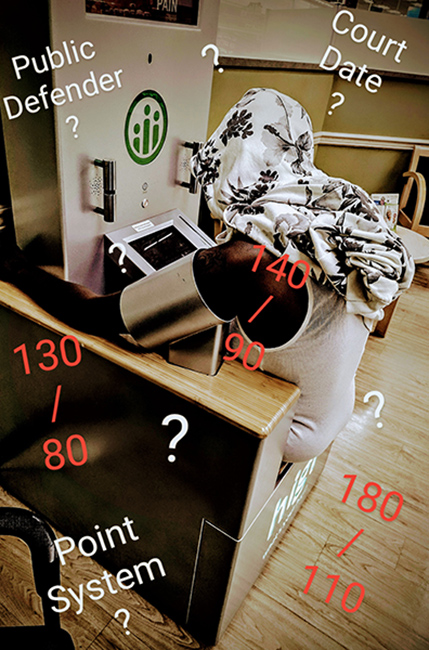
Stress, anxiety, and fear of the unknown in my case was equivalent to severe high blood pressure issues.
Talyesse
The mental health, it spills off into the physical health. With the depression…I wasn't taking my medication properly. That meant I wasn’t eating properly. That meant I wasn't taking care of myself properly, which gave me more physical health ailments. You can't have one without the other. The deterioration of your mental health leads to the deterioration of your physical health. They are one and the same.
Baiyinah
The mental health and the physical health go hand-in-hand. Once I felt mentally just lost, I just stopped caring about my physical health as well. I couldn’t care about it because I just didn't even know where I was at that point.
Talyesse
The photographers named particular aspects of pretrial monitoring that affected their health. One worried about whether and how medications might show up on mandatory drug screens. Talyesse described how her reduced mobility because of electronic monitoring led to weight gain and reduced cardio fitness. Things that felt easy previously, like walking up a flight of stairs, became difficult.
During that time, I just couldn’t be as active as I would have liked, which I am very, very, very active. I move around more than I’m sitting still. And I gained so much weight at that time. I started dealing with high blood pressure at that time, which was strange because I’d never had a high blood pressure issue. The limited mobility as well was affecting my physical health. It genuinely was. I remember walking up somebody’s steps. They lived on the third floor and I’m like, “Damn, that was hard.” And for somebody like me, I never experienced that part of it either.
Talyesse
Pretrial detention and health
Spending time in jail—sometimes even just a few days—can be detrimental to a person’s health. Jail time may compound existing health disparities, as it is linked to higher rates of HIV, hepatitis C, tuberculosis, hypertension, asthma, arthritis, cervical cancer, anxiety, depression, substance abuse, and comorbidities.
The photographers expressed a sense that the criminal legal system did not show enough care for people’s physical health while they are detained. Zooming in on a packet of instant ramen noodles, Talyesse highlighted how food provided to people who are in jail shows a lack of regard for people’s dietary needs. She draws a connection between diet and health concerns, such as high blood pressure and diabetes:
I refuse to eat [instant ramen noodles]. I refuse to buy them. I don’t want them anywhere around. I just think they’re so unhealthy. It’s like the sodium content is ridiculous. [When I was making this photograph,] I was gonna put a basket with a bunch of chips and stuff in it too, but I’m like, this is just it for you. It’s no other options. There’s no healthy menu. No menu for diet or for health conditions. We’re in here [jail], but it is so inhumane. If it was actually corrective for me, I would get it. But it just seems like more of just punishment, not reinforcement. So, I feel like I had to show the photo to show how you really don’t get any options.
Talyesse

Every day of incarceration, inmates face serious health risks due to the poor conditions of the facility—not to mention the extremely limited options of certain foods. Individuals face diabetes, high blood pressure, high blood sugar, heart disease, and having stroke.
Talyesse
The photographers also wanted to see better communication between jails and public health systems so that the health needs of people who are detained are tended to quickly. For example, one photographer’s asthma flared up while she was in jail, and it took over a week for the jail to procure the medication she needed. Without her records, she had to tell the officials again and again what medications she was allergic to and which she needed. She asked, “How do you not know this? And how many times do I have to say this?” When her inhaler finally arrived, it was kept in a part of the jail that was too far for her to easily walk to during asthma flare-ups.
The photographers also noted that communication between the criminal legal and public health systems should improve when people are exiting jail. People may lose access to health insurance while jailed or may enter jail without insurance at all and may need help connecting with public benefits to continue their medical care or access needed medications.
Once you’re arrested, you lose so much. [They should] make sure that people have proper care. Even if it’s a facility that people can just go to for like temporary Medicaid or something until they can like get established. Going to the emergency room costs so much. And it comes from this situation [going to jail]. I understand that you may have done something wrong to put yourself there, but I just don't think that it is fair that a person may not have medical insurance and that’s just okay coming home from jail or whatever.
Talyesse
When I first lost my job due to the charges, I lost my medical insurance. It was a big gap in the time between I got insurance again because I was drawing unemployment and they was saying that my unemployment was more than the amount I was allotted to have monthly to get NJ family care so I wasn’t eligible for that. And yeah, so I didn’t have no insurance for a while.
Baiyinah
Talyesse said some people who are detained pretrial may feel reluctant to share details about their health with medical professionals. She attributed this to a lack of privacy, where patients are separated from one another by only a curtain, and it is easy to overhear conversations.
3 “I would have loved to be there” The pretrial period strains family relationships
When my father was passing away, he was in an induced coma for a while and I was on the ankle bracelet, pretrial services. We had our own officers, but you could only get in touch with them Monday through Friday. And unfortunately, when I had to decide to pull the plug on my dad, I had to do it over the phone because I could not get in touch with the officer to be granted approval to go to another town to go to the hospital where he was at…I would have loved to be there, and I can't ever get that back.
Talyesse
Pretrial processes—including arrest, monitoring/release conditions, and detention—strained the three photographers’ family relationships and changed their roles within their families. With pretrial detention, people are not able to physically be with and care for their family members, including dependents. In the case of pretrial release, restrictions on their travel may mean that they cannot participate in important moments like birthday parties, funerals, and hospital visits. “For nine months, I sat at home with an ankle monitor on. I could not do anything,” Talyesse said. “At the same time, in those nine months, my father was literally dying, and I could barely go see him without permission.” Talyesse submitted a black-and-white photo of her father’s funeral program.
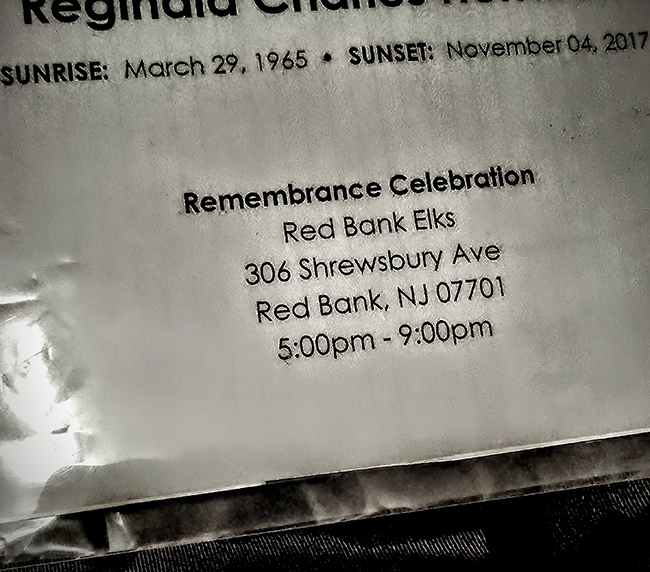
Suffered the loss of my father while fighting a criminal case. I missed his last days because I couldn’t get in touch with my pretrial services over the weekend to request to visit him for the day he went brain dead.
Talyesse
The photographers were not the only members of their families or communities who had been entangled with the criminal legal system. For some, the absence of other family members who were detained pretrial was felt strongly. Two photos focus on that absence: Pooda submitted a photo of a father standing in front of a house in need of repair, focusing on who was not in that picture—two sons who can’t help him while they are detained pretrial.
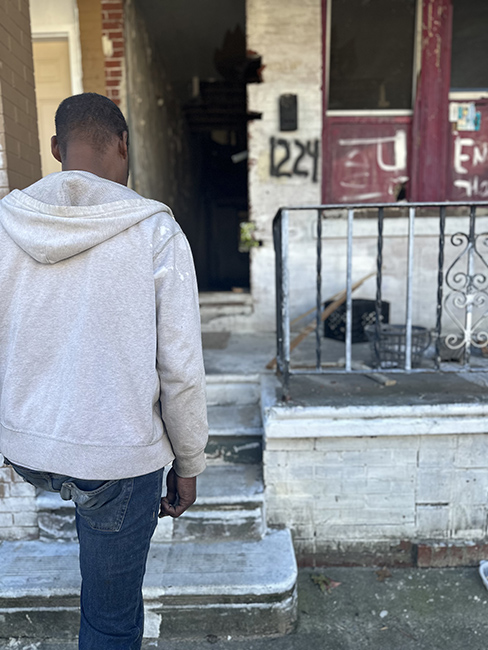
This is a photo of a father who cannot manage the housing renovations on his own. His two sons are awaiting a pretrial release date.
Pooda
Similarly, his second photo of a yard of sporting and recreational equipment is marked by absence: no family members use the grill, basketball hoop, or ATVs in the background. The caption points to the negative impact that incarceration can have on the family’s overall mental health and children’s development when an adult is absent and unable to engage in recreational activities with their children.
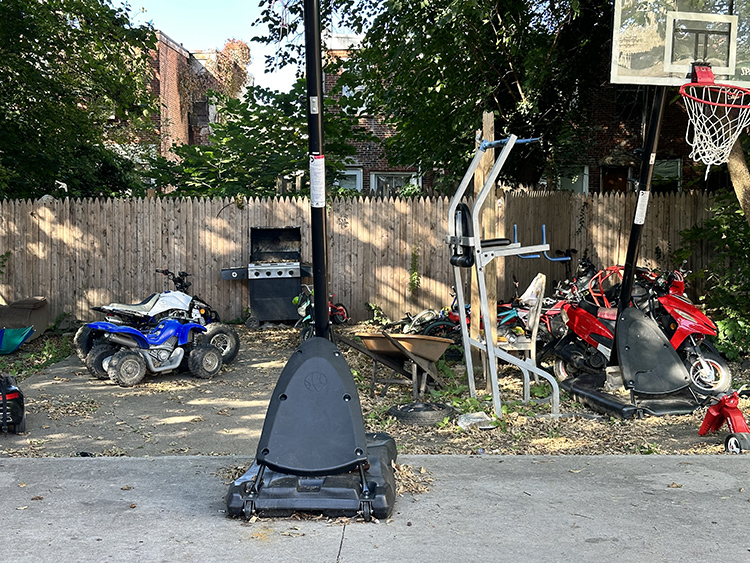
These abandoned activities show the lack of family engagement for overall family mental health and child development. Families impacted by incarceration also have family needs that go beyond expected adulthood priorities.
Pooda
Baiyinah described the worry she felt about how her potential absence from her family would affect them: “I have children that’s in the judicial system. The support that they depend on me for, I'm not gonna be able to give them [if I am incarcerated].” With her family members jailed, she also wondered if there would be anyone to support her if she was also incarcerated.
The loss of ties to family and close personal networks can have strong implications for mental health. Connection with family has been linked to a reduction in depression, and support from family and friend networks are seen as protective factors against mental health disorders.
4 “I’m in recovery mode” Pretrial detention and monitoring worsen personal and community financial circumstances
The three photographers highlighted that pretrial detention, electronic monitoring, and having an open case negatively impacted their employment and financial circumstances, which, in turn, affected other aspects of their wellbeing, including mental and emotional health, family relationships, and community ties.
Even a short period of time in jail has been linked to job loss, continued unemployment, and less economic mobility. This matches the experience of one photographer who described losing her job after a short stay in jail. However, the photographers' challenges with employment didn’t stop with detention: electronic monitoring made it harder for them to maintain their jobs, as did simply having an open case. One photographer who was on electronic monitoring described how the process to request permission to go to specific locations wasn’t nimble enough for her to work a job that required her to travel.[2] Similarly, the photographer who lost her job after being booked into jail described being turned down for jobs because employers didn’t want to hire someone with an open case. It was two years before she was able to find a new job, 15 months of which she was waiting for her case to be resolved.
I did go home on a bracelet. I couldn't do anything. Like, the restrictions were crazy. So, it was like, even with a job…coming in with the ankle bracelet on was already a sign of no. Like, “Why would we have you in here with this thing?” I had a family flooring company that I was a part of, but I couldn't go from house to house, town to town because we can't put that on a set schedule. The bracelet stopped a lot.
Talyesse
[While waiting for my case to be resolved] I was blocked from doing DoorDash and Uber because of the open charge I had. I couldn’t even use my own car to make income after not being able to find other jobs.
Baiyinah
The photographers described how these changes in their employment could strain their finances, placing stress on their families. They contrasted this with the times in their lives where they felt the healthiest—when they had job stability and the financial flexibility to take part in activities that brought them joy.
Whether it’s pretrial or felonies, people typically have a difficult time getting a lease. Landlords deny us. Because of that, we are in a very bad spot when it comes to getting our own housing. We [people with experience in the criminal legal system] have other family or our significant others assist us in getting housing. They sign on the lease.
Pooda
[At times when I’ve felt at my best], it was job security. I had a more active social life. [Before the case], I went to the botanical gardens, to the aquarium a lot, hanging out at the Met. Now I’m not doing as much as I’d like to do…Right now, I’m working, but I’m in recovery mode. Without no job and income, everything suffered. I got incarcerated, lost my job [and] my insurance. I didn’t have a stable income, I had 20 credit card accounts, so my credit score suffered. I’m working now, I’m in repair mode now.
Baiyinah
The photographers also made clear that the effects on their financial wellbeing could last well beyond the pretrial period. Bias in hiring people with criminal records can make it hard to find work, as shown in Talyesse’s photo of a job application tossed in the trash with the words “do not hire” on it. Talyesse crafted the image to show not what she tells people when applying for a job, but what they hear when they learn she has a record. Her address is replaced with that of a prison; her educational status, a prison identification number; and the message of “do not hire” is spread across the form.
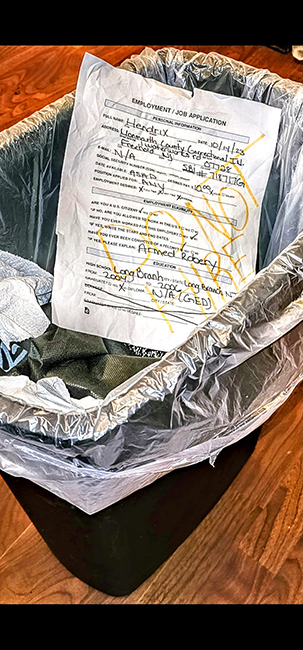
From unemployment to recidivism.
Talyesse
The photographers made a connection between having a criminal record and challenges affording and obtaining housing. Their photos point to the structural costs of involvement in the criminal legal system: in one photo an image of homeless individuals is positioned next to a police station, and in another the haves and have-nots are shown as so geographically close but economically distant.
The criminal justice system is a business. There is a profit to be made. When the state has to use tax dollars to pay for a human being to be put in inside of a cage, they’re paying upwards of 50, 60 thousand dollars more than they would pay for someone to go to college.
Pooda
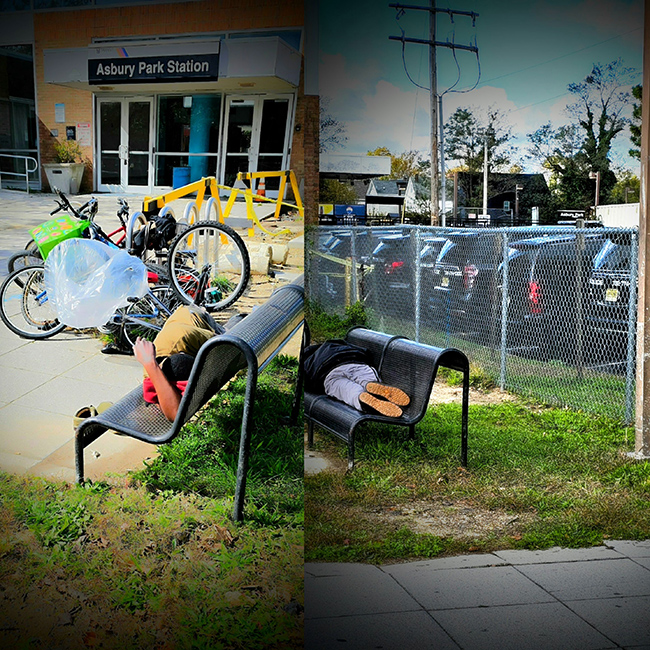
We live in a world where homeless individuals have become so accustomed to multiple arrests that the train station, which sits next door to the police station, is conveniently their home.
Talyesse

This shelter has the capacity to hold only 37 homeless men and provide only 50 meals daily, which costs $2.82. It is a first-come, first-serve basis, and 10 days is the maximum stay. Meanwhile, we pour over $80 billion into a prison system every year.
Talyesse
Several studies add evidence to the claims of photographers. Employers have been shown to discriminate against people who have minimal criminal legal system involvement, such as arrests for minor charges that did not result in conviction. When people with criminal records do land jobs, they tend to earn less money than their peers. And individuals’ experiences with homelessness and the criminal legal system can be cyclical: people with criminal records and those leaving jail and prison are more likely to experience homelessness, and people who experience unsheltered homelessness interact at higher rates with the criminal legal system.
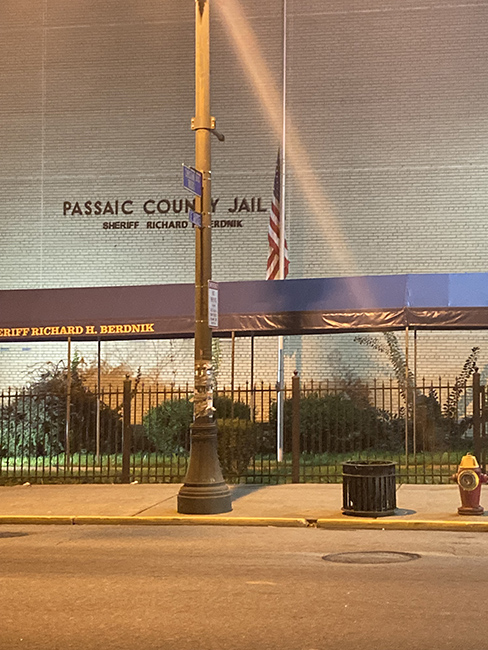
Where the faceless go to, never to be claimed.
Baiyinah
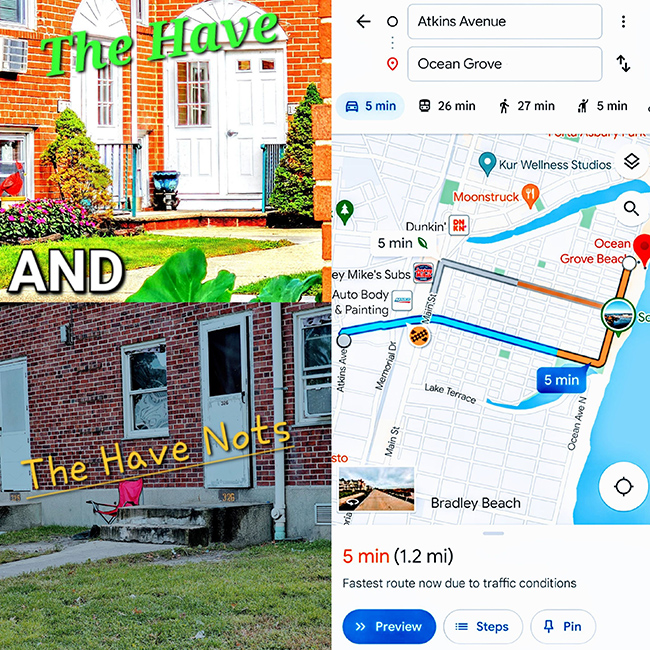
Segregation, disadvantage, crime, and wealth are all within five minutes apart.
Talyesse
5 “It’s like you have this invisible label on you” The stigma of being charged and arrested
Once you get arrested, it’s like you have this invisible label on you. It’s not after convictions; it’s after arrest. You have this invisible label that changes how people treat you. Employers, court folks, your community. Your value to society has diminished 90 percent. You mean nothing anymore. Step to the side. You have no value anymore.
Baiyinah
For the photographers, being accused of a crime completely transformed how they were viewed by the world—and even how they viewed themselves. At the point of arrest, they felt that the world attached an invisible, unremovable label that reduced all they were as people to a single fact about them: that they had been accused of (but not convicted of) a crime. And because they had been accused of committing a crime, they were treated differently: with less respect and more hostility, in a dehumanizing manner. This shift showed up both in how certain members of their community viewed them and in how the criminal legal system treated them throughout the pretrial process.
“Social death”: the community and personal impact of the stigma of arrest
The photographers felt they were treated with more judgment from some members of their community after their arrest. Talyesse said she stopped receiving the respect that she used to receive from some friends and family. Baiyinah said she experienced “social death” after newspaper coverage of her arrest was circulated on social media by people in her religious community. Both photographers felt that their charges affixed them with labels that they could do nothing to change.
For Talyesse, this label also changed how she saw herself. She worried that others would see her only as her charge. This reduced her confidence and contributed to her worsening mental health during the pretrial period. She explained, “A lot of it could also have been my own perception, but it was something that really, really, really did bother me mentally because I felt like once I got arrested, that was just my label. It hindered me from so much.”
Being viewed as a criminal by the police, courts, and system
In their interactions with some court officials, the photographers felt as if the full scope of their identities was not acknowledged. They felt this most strongly at three key points: 1) while being arrested, 2) when officials did not clearly explain procedures or processes, assuming that they had been arrested before, and 3) when feeling pressure to plea bargain.
Of her experiences during arrest, Baiyinah said, “The police just presume you are automatically guilty of whatever it is they think you're guilty of. And at that moment, they strip you of your humanity.” She submitted two photos illustrating the arrest process. In the first one, Baiyinah depicted someone who was presumed guilty (and therefore dangerous) from the moment they were pulled over and told to put their hands on the vehicle. The second photo shows the mistreatment of a person being arrested. “This is the treatment that you get, face down in the pavement, no compassion, no empathy, no sympathy, no nothing,” Baiyinah said. “They treat you like you are less than an animal.”
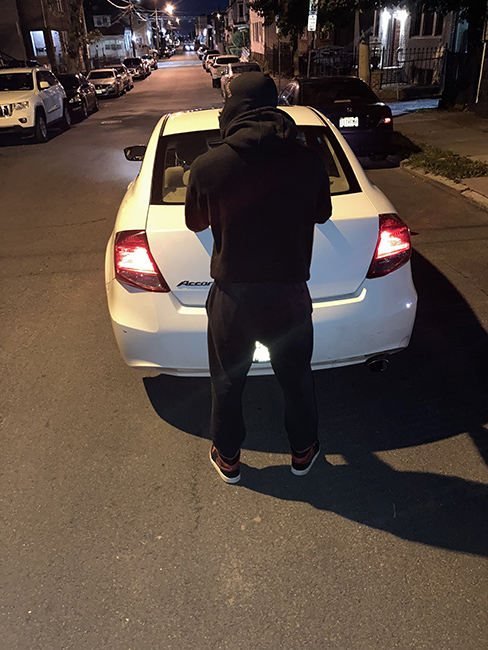
You have the right to be guilty until proven innocent. This one was about how they pull you over and automatically presume you’re guilty and strip you of humanity. “Get out, put your hands on the car.”
Baiyinah
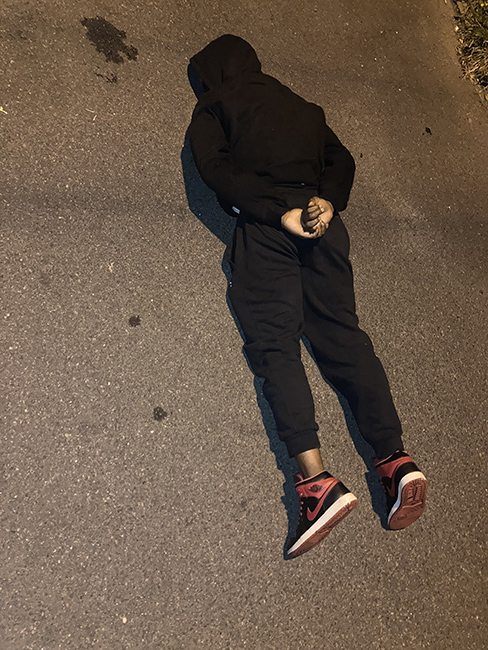
You are not human. “I don’t care that you have not done anything. Eat the pavement; you are a threat to me.” This one is a bit emotional topic on how the police just presume you are automatically guilty of whatever it is they think you’re guilty of. And at that moment, they stripped you of your humanity.
Baiyinah
When trying to understand whether or under what conditions she would be released pretrial, Baiyinah found that information was rarely explained to her. Instead, she encountered the assumption that she must have been jailed before and would already know what was going to happen. She explained, “It’s like they automatically assume that once you’re standing in front of the judge that you are like this hardened criminal that been in front of the judicial system a million times. Nobody explains nothing. ‘So, you know, you a criminal, you here, you know.’ No, I don’t know, sir. I don’t know.”
Both Baiyinah and Talyesse felt pressed to plea bargain because of how they were treated during the pretrial process. They worried that they would not get a fair shot in court, that some court officials had already taken sides, and that people take plea deals for things they didn’t do. This perception is backed up by national trends: more than 90 percent of convictions are the result of a plea deal. One of the effects of plea bargaining is that innocent individuals may forgo their right to a trial to reduce the risk of losing their case and having to face a full prison sentence. In a literature review of studies, researchers concluded that in some cases the offer of a plea bargain may “effectively coerce people who are factually innocent into pleading guilty.” An analysis from the forthcoming NJ CARE final report found that the percentage of people in New Jersey who took plea deals increased after the implementation of CJR.
I couldn’t understand how a lot of people take pleas, cop outs that they know that they didn’t do. Going through this myself, it made me aware that you feel so lost and depleted, that this has caused so much havoc in your life, you want this to be over with. Not knowing this, you take pleas and offers. You get locked up for stuff you didn’t even do. They gave you little information, it’s not an inclusive process, your public defender/attorney is making deals with the prosecutor without them telling what’s going to happen to you. You’re just lost. You want this to be over. If this means it’s going to be over, I’m going to be okay with that.
Baiyinah
The stigma of being accused of a crime felt like it followed the photographers everywhere: at the point of arrest, at home, and in their interactions with the court. They felt dehumanized, like the simple act of being accused transformed how they were viewed by community members, friends, family members, and members of the criminal legal system.
Recommendations and Conclusions
The three photographers in the photovoice project depicted how their interactions with the pretrial system worsened their feeling of wellbeing. They saw declines in their mental and physical health. Their family relationships were strained. They pointed to lasting changes in their employment and financial stability that affected not only themselves but their entire communities. And they felt that their communities and the criminal legal system determined that they were guilty before their cases were disposed of. The photographers felt these effects were critical for police officers, attorneys, judges, and policymakers to understand when making decisions about the design of the pretrial system.
The photographers offered several recommendations for improving people’s experiences with the pretrial system and reducing negative consequences for wellbeing.
- Increased communication about the pretrial process and timelines. The photographers felt confused about pretrial processes, especially the Public Safety Assessment (PSA) tool, and wished that court officials took the time to explain how a decision would be made about whether and under what conditions they would be released. They also wanted more transparency throughout the pretrial period about what steps would take place, the status of their case, and the timeline for decisions to be made. Specifically, they recommended that the court provide people who have been accused of a crime with written materials explaining the pretrial process in simple terms. They also suggested creating peer mentoring programs that pair people who are defendants with people who have already navigated the pretrial process, offering guidance and additional support throughout the process.
- Robust representation from public defenders starting from the earliest pretrial processes. When someone is arrested on a warrant in New Jersey, the individual is booked into jail and detained until a final PSA score is calculated and a hearing is held where a judge determines whether the person will be detained or released and what the monitoring requirements will be. The photographers who took part in this study felt confused throughout these early processes; they didn’t understand why they had been detained and whether or if they would be able to return home. They reported having little access to the public defender who would represent them at this early hearing and feeling unsure that the attorney had the details of their case right or even remembered their name. Their experiences point to a need for more robust representation at the earliest pretrial processes, especially when people are detained prior to their hearing.
The photographers are not alone in finding that their public defenders did not have enough time to keep them informed about their cases. Public defenders nationwide are notoriously overburdened with caseloads that make it difficult to give each client the time and attention needed. New caseload standards adopted in 2023 by the National Legal Aid and Defender Association acknowledge that the older standards, which had been in place since the 1970s and were frequently exceeded, hindered public defenders from being able to provide adequate representation to their clients. While the old standards assumed all cases required the same level of effort, the new standards acknowledge that different kinds of cases will take more effort than others. An analysis found that public defenders in New Jersey averaged 189 new felony cases each in fiscal year 2022 (which require many more hours than lower-level cases), many times higher than the new recommended standards. The analysis estimated that New Jersey, which had 289 public defenders at the time, would need to hire an additional 600 attorneys to meet the more robust guidelines. - Improved medical care during the pretrial period, especially while detained. Many people who enter jail have serious mental and behavioral health conditions, substance use disorders, and other health conditions. The photographers recommended improving individuals’ access to health care during pretrial detention. Their personal experiences highlighted gaps in care while detained, such as lack of access to needed medication and lack of access to important medical records. They suggested that improved coordination between public health and correctional services could facilitate access to important records and medications. They noted that the lack of privacy in jail could make people less likely to share medical or mental health needs with medical officials, and they suggested that steps be taken to allow for more privacy when discussing health concerns.
The need for access to medical care does not end if someone is released from detention. Many people enter jail without any health insurance, and people who are detained, even for a short period, may lose their jobs and their health insurance. Moreover, because the law prohibits the use of federal Medicaid funding for people who are incarcerated, many people lose their coverage when they are booked into jail and must reapply for benefits upon their release.[3] The photographers recommended strategies to connect people leaving jail to Medicaid, such as by referring people to benefits navigators or allowing people to enroll while detained. In 2024, New Jersey introduced two bills to increase access to Medicaid for individuals leaving incarceration. As of April 2024, both were referred to committee.[4] - Supportive approach to pretrial services. The photographers wanted to see a more supportive approach to pretrial services that focuses on connecting people to services that could help them achieve better pretrial outcomes. One photographer expressed that it seemed backwards to expect people to meet pretrial release conditions without addressing any of the underlying needs that could have contributed to their initial arrest, such as homelessness or mental health challenges. The photographers also wanted to see support for people and their families during this period, such as improved connections to health care, access to mental health and therapy services, benefits navigation, and special programs for parents. One photographer explained, “There was no mother-and-son program for me to try to do some therapy with my kid so he could understand like, you know, what's really going on or, or how I could work through it with him because I don't know how.” Such a program could have helped her and her son prepare for her pending incarceration.
Recognizing the prevalence of risk factors such as homelessness, untreated mental health conditions, substance use disorder, and a history of trauma among people who come into contact with the criminal legal system, jurisdictions across the country are exploring offering supportive approaches to pretrial services, including New Jersey. In 2023, New Jersey introduced legislation to expand a pilot to conduct needs assessments and provide wraparound services. Under the proposed legislation, people arrested in certain counties who are released on their own recognizance could voluntarily participate in a program that would offer individualized service plans that could include treatment for substance use disorders; medical, mental, or behavioral health services; and employment services. Successful completion of the program would be considered in charging and sentencing decisions. While this legislation could be a positive step forward, the photographers recommended a broader range of supports for more people who are accused of a crime across the state. - Use the least restrictive release conditions. The photographers found that both pretrial detention and more intensive levels of pretrial monitoring, such as electronic monitoring, could disrupt their families and strain their relationships. For instance, Talyesse could not receive permission from pretrial services quickly enough to be present when her dying father was taken off life support. Electronic monitoring requirements could also have negative effects on their ability to work, especially for jobs that required them to travel, because pretrial services could not grant permission to travel rapidly enough to accommodate shifting worksites. The photographers wanted to see more nimble responses to requests to travel for people on electronic monitoring, which could make it easier for people to maintain their jobs and be present for important moments. In particular, they wanted to see procedures for emergency dispensation to visit sick or dying relatives.
Compared with money bail, pretrial monitoring does not lead to increases in arrest or failure to appear in court. However, there is little evidence that more intensive monitoring has positive effects on pretrial outcomes. A recent study from MDRC found that lower-intensity supervision was as effective as higher-intensity supervision in helping clients appear in court and avoid new arrests. The analysis found no evidence that requiring people to meet more intensive pretrial supervision requirements improves outcomes. Electronic monitoring, one of the most restrictive forms of monitoring, has not been shown to lead to better pretrial outcomes. And it has been linked to increased rates of technical violations and poorer pretrial outcomes for people with lower-risk assessments. While pretrial monitoring is less restrictive and costly than detention, it comes with costs to individuals and society that should not be overlooked. Overall, research suggests that policymakers should opt for the least restrictive monitoring conditions possible and to use more restrictive conditions only when it is likely to improve a person’s pretrial outcomes regarding court appearance and rearrest.
New Jersey’s 2017 criminal justice reforms led to important changes to the pretrial system, including reducing custodial arrests, shortening the length of initial jail stays, and increasing fairness in the system by eliminating the use of money bail. However, the three photographers’ experiences in this study indicate that more changes are needed to reduce the toll that pretrial involvement can take on people’s mental, physical, financial, and social health. The photographers made many recommendations for improving the wellbeing of people who are facing charges in New Jersey. More rigorous research on these strategies may help identify evidenced-based approaches to pretrial justice reform. State policymakers, local officials, and researchers should continue to solicit the insights and recommendations of people with direct experience with the pretrial system as they continue to develop and test reform strategies. These perspectives are critical to understanding the current state of reform and meaningful recommendations for change.
Artist Statements and Photos
Baiyinah
Baiyinah is a community activist and substance abuse counselor based in New Jersey. Her experience as an African-American woman and single mother living in urban America shapes her approach to photovoice research.
In her photo collection, Baiyinah aims to draw attention to the lack of respect and humanity in how people are treated in the criminal legal system. Her photos also explore the long-lasting affects that arrest and criminal legal system experience have on people. Her professional interest in trauma and the criminal legal system are also evident in the photos. She notes that for many people, the experience of being put in handcuffs, put in the back of a police car, being finger-printed, and getting strip searched are abnormal, traumatizing, and shocking experiences, particularly for people who have never been arrested before. She hopes that her photos drive people to consider the long-term physical, mental, financial, and spiritual effects that arrest and detention have on an individual.
Baiyinah hopes that her photos will move at least one police officer, lawyer, judge, or prosecutor to change the way they think about individuals going through the pretrial system and reconsider how they approach and treat that individual. She hopes that her photos will inspire people in the pretrial system to treat everyone with a high degree of humanity and respect and to reconsider on a case-by-case basis whether arrest, detention, and pretrial restrictions are necessary.
Pooda
Pooda is a New Jersey resident who participated in the photovoice study. In his photos, Pooda shows how the criminal legal system affects the communities and families of people who are arrested and detained pretrial.
Pooda hopes that people will walk away from the photovoice study more educated about the criminal legal system and its impact on individuals and communities. He believes that more people who have been directly impacted by the criminal legal system should be involved in criminal justice research and policy in New Jersey.
Talyesse
Talyesse is an advocate, a poet, a writer, a parent, and a friend. She spent her whole life on the Jersey shore. She spends her free time finding ways to fulfill the needs of those suffering from poverty, which fueled the ambition behind Talyesse starting her own business called Drive By, a community outreach nonprofit that travels through several towns and delivers endless amounts of essentials to different homeless communities. Talyesse lives her life by being able to empathize with individuals because of their upbringings and their stories due to her beliefs that who we are can be easily influenced by who we were taught to be. She enjoys writing poetry, spending time with her family/friends, listening to music, and listening to the roaring waves of the beach.
In her photos, Talyesse wants to shed light on the causes of mass incarceration, drawing attention to a lack of investment in her community’s resources for families and homeless individuals. Her direct experience with New Jersey’s criminal legal system, as well as her direct experience growing up in poverty and beating the odds of recidivism, helped her understand how people can become stuck in the criminal legal system. Her photos also focus on the impact that arrest and incarceration have on the lives of people’s immediate families and how they suffer alongside the person incarcerated.
Talyesse hopes her photos help people understand what she sees and believes in her community: that people are not born criminals and that many life and community factors influence arrest. With this photo series, she hopes to change the stigma around being arrested.
Methodology
Methods
The research team consisted of three photographers and two MDRC researchers. Over the course of three months, the research team used the photovoice methodology to explore how the New Jersey pretrial system affected individuals’ sense of wellbeing. Photographers were asked to take photos of people, places, and things that showed how their mental health, physical health, financial health, and social relationships changed during the pretrial period. Photographers then gathered to discuss why they submitted these particular photos and to analyze them using a discussion framework called the SHOWeD method (see box). SHOWeD is a mnemonic for a set of questions designed to generate a dialogue on the root causes and potential solutions for an issue of focus. The project culminated in the digital gallery and themes published here.
SHOWeD Discussion Questions
- What do we literally see in the photo?
- What is really happening in the photo?
- How does this photo relate to our lives?
- Why does this condition exist?
- What should be done to address these challenges?
Photographers
MDRC partnered with the New Jersey Institute for Social Justice, a Newark-based advocacy organization, to recruit photographers. To participate in the study, individuals had to be at least 18 years old, have been arrested after New Jersey’s Criminal Justice Reform went into effect in 2017, and not be incarcerated at the time of study enrollment. They also had to have access to a smart phone with a camera and internet/data access. Three photographers participated in the study; however, one photographer was not able to participate in the discussions but did complete an interview and submit photos.
Procedures
The research activities included: individual interviews, an orientation, two photo submission periods, two SHOWeD discussion group meetings, and one final theme analysis session. All activities took place remotely by Zoom, and participants were provided with tokens of appreciation for their participation (see table).
|
Activity |
Incentive |
Description |
|
Interview |
$50 |
60-minute, semi-structured interviews focusing on demographic information, experiences with the criminal legal system, and goals for participating in the study. Interviews were recorded. |
|
Orientation |
$75 |
90-minute group orientation on Zoom focused on photovoice method, research and photo ethics, processes for securely submitting their photos, procedures for requesting photo releases, and photo composition skills. |
|
Photo collection (2) |
$25 per photo |
Photographers took photos and wrote short captions to show how their wellbeing was affected during the pretrial period. Photos were collected over two submission periods, and a total of 22 photos were submitted using Qualtrics, a secure survey platform. |
|
SHOWeD discussion meetings (2) |
$75 |
90-minute group discussions were held after each photo collection period. Photographers chose one or two photos to discuss using the SHOWeD method. These discussions were recorded and transcribed. |
|
Group analysis of themes |
$75 |
The MDRC research team reviewed the interviews, photos, and transcripts from the discussion to identify themes from the study. The MDRC researchers shared these themes with the photographers during a 90-minute analysis call. Photographers confirmed whether the themes aligned with their experiences and perspectives, suggested additional themes and recommendations, and recommended edits to improve accuracy. The MDRC research team made edits based on the photographers’ feedback, which became the core findings presented here. |
|
Final meeting |
$75 |
Individual meetings with photographers in which they drafted artist statements, chose which photos to share publicly, and decided how they’d like to be credited. Photographers had the option to share all or part of their name or to choose a pseudonym. |
Notes and References
Notes
[1] Wellbeing is a public health concept that refers to the presence of positive emotions (such as happiness) and the absence of negative ones (such as fear). Socioeconomic factors, relationships and community ties, physical health, mental health, emotional health, and other factors can all contribute to wellbeing.
[2] A report from the Shriver Center on Poverty Law also found electronic monitoring to have adverse effects on employment. The authors argue that people on electronic monitoring may effectively be barred from working in service and shift jobs, because some of the jobs most frequently available to people with criminal records have unpredictable hours and shifting locales.
[3] In New Jersey, Medicaid eligibility is terminated after a person is detained for more than 30 days. For more information on Medicaid and incarceration, see Cardwell and Gilmore (2012). For more information on Medicaid polices for people incarcerated in New Jersey, see Harr (2013).
[4] As of January 2024, two bills related to this topic were pending review by the Public Safety and Preparedness Committee. See https://www.njleg.state.nj.us/bill-search/2024/A2057 and https://www.njleg.state.nj.us/bill-search/2024/A2828 for information on the status of these bills and links to the full text. For additional background on the introduction of legislation to increase incarcerated individuals’ access to health care in New Jersey, see Stainton (2020).
References
Advancing Pretrial Policy and Research. n.d. “What is Pretrial Justice?” Website: https://advancingpretrial.org/pretrial-justice/pretrial-justice/.
Albertson, Elaine Michelle, Chrisopher Scannell, Neda Ashtari, and Elizabeth Barnert. 2020. “Eliminating Gaps in Medicaid Coverage During Reentry After Incarceration.” American Journal of Public Health 110, 3: 317-321. Website: https://www.ncbi.nlm.nih.gov/pmc/articles/PMC7002937/.
Alegría, Margarita, Amanda NeMoyer, Irene Falgàs Bagué, Ye Wang, and Kiara Alvarez. 2018. “Social Determinants of Mental Health: Where We Are and Where We Need to Go.” Current Psychiatric Reports 20, 95: 1-13. Website: https://link.springer.com/article/10.1007/s11920-018-0969-9.
Anderson, Chloe, Brit Henderson, and Kyla Wasserman. Forthcoming. NJ CARE Final Report. New York: MDRC.
Anderson, Chloe, Cindy Redcross, and Erin Valentine, with Luke Miratrix. 2019. Evaluation of Pretrial Justice System Reforms That Use the Public Safety Assessment: Effects of New Jersey’s Criminal Justice Reform. New York: MDRC. Website: https://www.mdrc.org/work/publications/evaluation-pretrial-justice-system-reforms-use-public-safety-assessment-0.
Anderson, Chloe, Erin Valentine, and Daron Holman. 2023. Assessing the Effectiveness of Pretrial Special Conditions: Full Findings from the Pretrial Justice Collaborative. New York: MDRC. Website: https://www.mdrc.org/work/publications/assessing-effectiveness-pretrial-special-conditions.
Berry, David. 2011. The Socioeconomic Impact of Pretrial Detention. New York: Open Society Foundations. Website: https://www.justiceinitiative.org/publications/socioeconomic-impact-pretrial-detention.
Binswanger, Ingrid A., Patrick M. Krueger, and John F. Steiner. 2009. “Prevalence of Chronic Medical Conditions Among Jail and Prison Inmates in the USA Compared with the General Population.” Journal of Epidemiology and Community Health 63, 11: 912-919. Website: https://pubmed.ncbi.nlm.nih.gov/19648129/.
Brinkley-Rubenstein, Lauren. 2013. “Incarceration as a Catalyst for Worsening Health.” Health and Justice 1, 3. Website: https://healthandjusticejournal.biomedcentral.com/articles/10.1186/2194-7899-1-3.
Brunson, Rod K., and Ronald Weitzer. 2009. “Police Relations with Black and White Youths in Different Urban Neighborhoods.” Urban Affairs Review 44, 6: 858-885. Website: https://journals.sagepub.com/doi/10.1177/1078087408326973.
Cardwell, Anita, and Maeghan Gilmore. 2012. County Jails and the Affordable Care Act: Enrolling Eligible Individuals in Health Care Coverage. Washington, DC: National Association of Counties. Website: https://www.naco.org/sites/default/files/documents/County-Jails-HealthCare_WebVersion.pdf.
Center for Disease Control and Prevention. n.d. “Well-Being Concepts.” Website: https://www.naspa.org/images/uploads/kcs/WHPL_Canon_WB_Well-Being_Concepts___HRQOL___CDC_2017.pdf.
Dobbie, Will, Jacob Goldin, and Crystal S. Yang. 2018. “The Effects of Pretrial Detention on Conviction, Future Crime, and Employment: Evidence from Randomly Assigned Judges.” American Economic Review 108, 2: 201-240. Website: https://www.aeaweb.org/articles?id=10.1257/aer.20161503.
Finlay, Keith, and Michael Mueller-Smith. 2021. “Justice-Involved Individuals in the Labor Market Since the Great Recession.” ANNALS of the American Academy of Political and Social Science 695, 1: 107–122. Website: https://journals.sagepub.com/doi/10.1177/00027162211024532.
Gase, Lauren Nichol, Beth A. Glenn, Louis M. Gomez, Tony Kuo, Moira Inkelas, and Ninez A. Ponce. 2016. “Understanding Racial and Ethnic Disparities in Arrest: The Role of Individual, Home, School, and Community Characteristics.” Race and Social Problems 8: 296-312. Website: https://link.springer.com/article/10.1007/s12552-016-9183-8.
Gelbach, Jonah B., and Shawn D. Bushway. 2011. “Testing for Racial Discrimination in Bail Setting Using Nonparametric Estimation of a Parametric Model.” SSRN Working Paper. Website: https://papers.ssrn.com/sol3/papers.cfm?abstract_id=1990324.
Geller, Amanda, Jeffrey Fagan, Tom Tyler, and Bruce G. Link. 2014. “Aggressive Policing and the Mental Health of Young Urban Men.” American Journal of Public Health 104, 12: 2,321-2,327. Website: https://www.ncbi.nlm.nih.gov/pmc/articles/PMC4232139/.
Hamer, Emily. “Public Defenders Work 3 Times Too Many Cases, Milestone Study and New Data Show.” St. Louis Post-Dispatch. September 12, 2023. Website: https://www.stltoday.com/news/nation-world/crime-courts/public-defenders-attorneys-dangerously-overworked/article_5a63628b-63d0-56dc-bc91-ce908820ac75.html.
Harr, Valerie. 2013. “Termination of Medicaid Benefits for Inmates of Public Institutions.” Medicaid Communication No.13-12. Trenton, NJ: State of New Jersey Department of Human Services, Division of Medical Assistance and Health Services. Website: https://www.nj.gov/humanservices/dmahs/info/resources/medicaid/2013/13-12_Termination_of_Medicaid_Benefits_for_Inmates_of_Public_Institutions.pdf.
Holsinger, Alexander M., and Kristi Holsinger. 2018. “Analyzing Bond Supervision Survey Data: The Effects of Pretrial Detention on Self-Reported Outcomes.” Federal Probation 82, 2: 39-45. Website: https://www.uscourts.gov/federal-probation-journal/2018/09/analyzing-bond-supervision-survey-data-effects-pretrial-detention.
James, Doris J., and Lauren E. Glaze. 2006. “Mental Health Problems of Prison and Jail Inmates.” Washington, DC: U.S. Department of Justice, Office of Justice Programs, Bureau of Justice Statistics. Website: https://www.ojp.gov/ncjrs/virtual-library/abstracts/mental-health-problems-prison-and-jail-inmates.
James, Patrice, James Kilgore, Gabriela Kirk, Grace Mueller, Emmett Sanders, Sarah Staudt, and LaTanya Jackson Wilson. 2022. Cages Without Bars: Pretrial Electronic Monitoring Across the United States. Chicago, IL: Shriver Center on Poverty Law. Website: https://www.povertylaw.org/report/cages-without-bars/.
Kochel, Tammy Rinehart, David B. Wilson, and Stephen D. Mastrofski. 2011. “Effect of Suspect Race on Officers’ Arrest Decisions.” Criminology 49, 2: 473-512. Website: http s://onlinelibrary.wiley.com/doi/abs/10.1111/j.1745-9125.2011.00230.x.
Kohler-Hausmann, Issa. 2013. “Misdemeanor Justice: Control Without Conviction.” American Journal of Sociology 119, 2: 351-393. Website: https://www.jstor.org/stable/10.1086/674743.
Kutateladze, Besiki L., Nancy R. Andiloro, Brian D. Johnson, and Cassia C. Spohn. 2014. “Cumulative Disadvantage: Examining Racial and Ethnic Disparity in Prosecution and Sentencing.” Criminology 52, 3: 514-551. Website: https://onlinelibrary.wiley.com/doi/abs/10.1111/1745-9125.12047.
Lerman, Amy E., and Vesla M. Weaver. 2014. Arresting Citizenship: The Democratic Consequences of American Crime Control. Chicago, IL: University of Chicago Press. Website: https://press.uchicago.edu/ucp/books/book/chicago/A/bo18008991.html.
Maruschak, Laura M., Jennifer Bronson, and Mariel Alper. 2021a. Survey of Prison Inmates, 2016: Alcohol and Drug Use and Treatment Reported by Prisoners. Washington, DC: US. Department of Justice, Bureau of Justice Statistics. Website: https://bjs.ojp.gov/library/publications/alcohol-and-drug-use-and-treatment-reported-prisoners-survey-prison-inmates.
Maruschak, Laura M., Jennifer Bronson, and Mariel Alper. 2021b. Survey of Prison Inmates, 2016: Indicators of Mental Health Problems Reported by Prisoners. Washington, DC: US. Department of Justice, Bureau of Justice Statistics. Website: https://bjs.ojp.gov/library/publications/indicators-mental-health-problems-reported-prisoners-survey-prison-inmates.
Maruschak, Laura M., Jennifer Bronson, and Mariel Alper. 2021c. Survey of Prison Inmates, 2016: Medical Problems Reported by Prisoners. Washington, DC: US. Department of Justice, Bureau of Justice Statistics. Website: https://bjs.ojp.gov/library/publications/medical-problems-reported-prisoners-survey-prison-inmates-2016.
Menefee, Michael R. 2018. “The Role of Bail and Pretrial Detention in the Reproduction of Racial Inequalities.” Sociology Compass 12, 5: e12576. Website: https://compass.onlinelibrary.wiley.com/doi/abs/10.1111/soc4.12576.
Metcalfe, Christi, and Ted Chiricos. 2017. “Race, Plea, and Charge Reduction: An Assessment of Racial Disparities in the Plea Process.” Justice Quarterly 35, 2: 223-253. Website: https://www.tandfonline.com/doi/full/10.1080/07418825.2017.1304564.
Metraux, Stephen, Caterina G. Roman, and Richard D. Cho. 2008. Incarceration and Homelessness. Washington, DC: U.S. Department of Housing and Urban Development. Website: https://www.huduser.gov/portal/publications/homeless/p9.html.
Mintz, Evan. 2020. “What Works and What Doesn’t in Pretrial Supervision?” Arnold Ventures. Website: https://www.arnoldventures.org/stories/what-works-and-what-doesnt-in-pretrial-supervision.
National Academy of Sciences, Engineering, and Medicine. 2017. “The State of Health Disparities in the United States.” Pages 57-97 in James N. Weinstein, Amy Geller, Yamrot Negussie, and Alina Baciu (eds.), Communities in Action: Pathways to Health Equity. Washington, DC: The National Academies Press. Website: https://nap.nationalacademies.org/catalog/24624/communities-in-action-pathways-to-health-equity.
National Legal Aid and Defender Association. 2023. “NLADA, BPDA, and ACCD Joint Statement on the New National Public Defense Workload Study.” Website: https://www.nlada.org/public-defense_workload_study.
New Jersey Courts. n.d. “Criminal Justice Reform.” Website: https://www.njcourts.gov/public/concerns/criminal-justice-reform.
New Jersey Legislature. 2023. “Assembly Judiciary Committee Statement to Assembly, No. 5268 with Committee Amendments.” Website: https://www.njleg.state.nj.us/bill-search/2022/A5268/bill-text?f=A5500&n=5268_S1.
New Jersey Reentry Corporation. 2023. Pre-Entry Report: A Research Examination of Best Practices. Jersey City, NJ: New Jersey Reentry Corporation. Website: https://njreentry.org/wpfd_file/pre-entry-report-2023-2/.
Pace, Nicholas M., Malia N. Brink, Cynthia G. Lee, and Stephen F. Hanlon. 2023. National Public Defense Workload Study. Santa Monica, CA: RAND Corporation. Website: https://www.rand.org/pubs/research_reports/RRA2559-1.html.
The Pew Charitable Trusts. 2010. Collateral Costs: Incarceration’s Effect on Economic Mobility. Washington, DC: The Pew Charitable Trusts. https://www.pewtrusts.org/en/research-and-analysis/reports/0001/01/01/collateral-costs.
Shaffer, Roy. 1983. Beyond the Dispensary. Nairobi: The African Medical and Research Foundation. Website: https://www.amoshealth.org/wp-content/uploads/sites/62/2019/10/Beyond-the-Dispensary.pdf.
Shah, Arnav, and Shanoor Seervai. 2020. “How the Cash Bail System Endangers the Health of Black Americans.” To the Point (blog), June. Website: https://www.commonwealthfund.org/blog/2020/how-cash-bail-system-endangers-health-black-americans.
Skemer, Melanie, Cindy Redcross, and Howard Bloom. 2020. Pursuing Pretrial Justice Through an Alternative to Bail: Findings from an Evaluation of New York City’s Supervised Release Program. New York: MDRC. Website: https://www.mdrc.org/work/publications/pursuing-pretrial-justice-through-alternative-bail.
Spohn, Cassia. 2015. “Race, Crime, and punishment in the Twentieth and Twenty-First Centuries.” Crime and Justice 44, 1: 49-97. Website: https://www.journals.uchicago.edu/doi/abs/10.1086/681550.
Stainton, Lilo H. “A ‘Bold Step Forward’ in Inmate Health Care.” NJ Spotlight News, January 27, 2020. Website: https://www.njspotlightnews.org/2020/01/a-bold-step-forward-in-inmate-health-care/.
Subramanian, Ram, Léon Digard, Melvin Washington II, and Stephanie Sorage. 2020. In the Shadows: A Review of the Research on Plea Bargaining. New York: Vera Institute of Justice. Website: https://www.vera.org/publications/in-the-shadows-plea-bargaining.
Sugie, Naomi F., and Kristin Turney. 2017. “Beyond Incarceration: Criminal Justice Contact and Mental Health.” American Sociological Review 82,4: 719-743. Website: https://journals.sagepub.com/doi/10.1177/0003122417713188.
Uggen, Christopher, Mike Vuolo, Sarah Lageson, Ebony Ruhland, and Hilary K. Whitham. 2014. “The Edge of Stigma: An Experimental Audit of the Effects of Low-Level Criminal Records on Employment.” Criminology 52, 4: 627-654. Website: https://onlinelibrary.wiley.com/doi/abs/10.1111/1745-9125.12051.
United States Sentencing Commission. 2023. Demographic Differences in Federal Sentencing. Washington, DC: United States Sentencing Commission. Website: https://www.ussc.gov/research/research-reports/2023-demographic-differences-federal-sentencing.
The Urban Institute. 2020. “Five Charts that Explain the Homelessness-Jail Cycle – and How to Break It.” Website: https://www.urban.org/features/five-charts-explain-homelessness-jail-cycle-and-how-break-it.
Valentine, Erin, and Sarah Picard. 2023. Assessing the Effectiveness of Varying Intensities of Pretrial Supervision: Full Findings from the Pretrial Justice Collaborative. New York: MDRC. Website: https://www.mdrc.org/work/publications/assessing-effectiveness-varying-intensities-pretrial-supervision.






